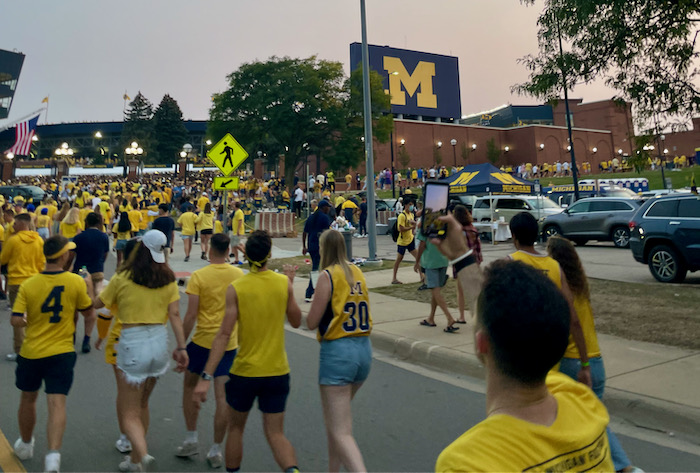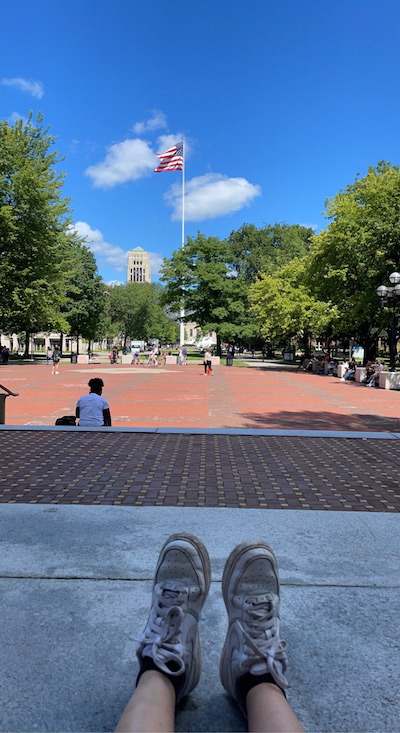
A dramatic show of community spirit was the University of Michigan’s powerfully intimidating “Maize Out” in the September 2021 football game against Wisconsin. Here’s news coverage of that game.
.
By EMILY BROWN
When I received my first homework assignment in grade school, I didn’t want to work at the desk in my room. I worked at our kitchen table. My father was grilling dinner on the porch and repeatedly popped through the sliding glass door, grabbing various utensils and condiments. My mother sat next to me. While occasionally talking with my father, she helped me with my addition and subtraction. Our cat meowed for her own dinner. Our dog scratched his little paw at the door.
The energy of the entire household was part of my education.
In fact, interactions with others at home and school were essential to my learning—until 2020, when the COVID pandemic changed the world. I started at the University of Michigan in the fall of 2019, then we were sent home in March 2020. We were expected to learn entirely via online connections through the summer of 2021.

BACK ON CAMPUS, FINALLY! Here, I’m simply sitting on the front steps of the famous Harlan Hatcher Graduate Library at the University of Michigan pondering the campus surrounding me.
Finally, in the fall of 2021, we could return to in-person classes. It felt like a homecoming.
Through that year of isolation, I had met a new version of myself: my bored and disengaged Zoom-school self.
In the apartment I shared with three other girls during that year, we each worked in our own rooms. Sometimes, for a change of pace, I would listen to my classes in our shared living space while wearing headphones. With my laptop’s microphone and camera turned off, Zoom class sometimes became background noise to making food, working out, or scrolling on social media. Eventually, though, sitting in my apartment began to feel suffocating.
For the most part, I would simply listen to class so I could do my assignments and submit them on time. Nothing about this online schooling felt interactive besides in smaller discussion sections where we were told to show our faces via Zoom or risk losing participation points. Besides required assignments, everything else from online school felt optional.
This past fall semester, returning to in-person classes felt wonderful. I love to be actively and physically learning. I thrive in environments where I can be wholeheartedly present in the experience. When I get to be physically present in class I can actively learn. If I can feverishly scribble notes, raise my hand to ask questions, and nod along with the professor’s lecture, then I am completely spellbound by the day’s subject.
“Real school” is a different type of hard than “Zoom school.”
Physically returning to the academic world, I felt the gears in my brain turning and adjusting. No pre-class reading or syllabus assignment was optional anymore like it felt while we were online. I was motivated to do well. I had been waiting for this return to somewhat normalcy since I began “Zoom school” in March 2020. I felt like I owed it to my Zoom-school self to work harder now that I was gifted the privilege of listening to a professor who was teaching physically in front of me.
The energy on campus shifted around me. The most notable shift was movement. No longer stuck in a single room, I felt freedom in each step. Walking to class with music playing loudly in headphones turned into mile-long concerts. Students with backpacks walked together to class and said hellos to friends who passed. Sidewalks were no longer just empty paths; they took us to new and exciting experiences.
At first, it was strange to actually walk to class again. My first class was on the top floor of the Burton Memorial Bell Tower. It was a twenty-five-minute walk across campus from my house so I had to leave at least thirty minutes early. Last year during Zoom school, I could wake up five minutes before the start of class, fire up my laptop and lay in my bed to listen to a lecture.
Now, I was physically climbing eight floors to my classroom, while wearing my mask, of course. Sitting at a desk with my phone packed away, pen in my hand, professor up front, and other students around me, I began to remember what “real school” was like.
Between classes, I rediscovered Ann Arbor’s energy. Wherever I was near campus, I could hear the bell tower chime. Walking along the Diag, clubs yelled out from their booths seeking new members. I would coffee shop hop since each was packed inside by groups that got to meet together to work on assignments. Coffee beans burrrred in grinders and espresso machines hissed. These sounds added extra life to the chill indie music playing softly from the speakers. At my third coffee shop visited in one day, there was only one seat left that I really hoped I could snag. Even if I couldn’t secure the seat, I was so grateful to have the possibility to try. I was thankful for movement, freedom, and a renewed dedication to learning that I shared with all these other people I was encountering each day.
Over that first in-person term, energy fluctuated like a roller coaster. Sometimes, the excitement rose like on a football game day when everyone was buzzing. Our hive is comprised of maize-and-blue-clad tailgaters who swarm the streets and walk to The Big House together. The excitement is elevated since it mixes with alcohol and anticipation of a winning football season.
When finals rolled around in December, the entire University of Michigan campus exuded stress. This stress emits a pressure that can either motivate or decimate confidence. Part of our learning as students is how to channel this energy. If we could adapt, we realized, we could survive such hurdles.
What I learned in my year of living in isolation with the pandemic is that energy is infectious—just like COVID. It spreads rapidly and we all can be hosts. While no one wants to host COVID, isolation sucks that energy out of our education.
Emily Brown is a ReadTheSpirit intern writing a series of columns about her experiences as a university student both at UofM and in other parts of the world. Her earlier column was headlined: ‘I Turned to Face the Mountain.’
